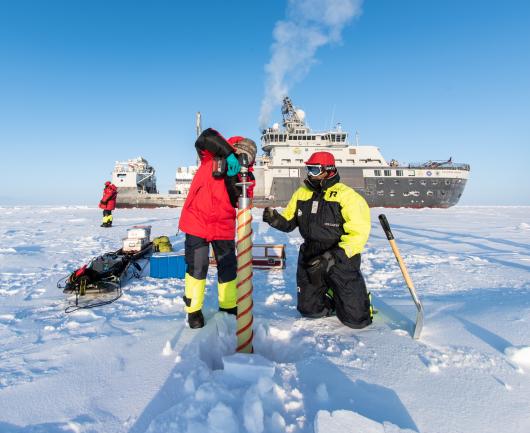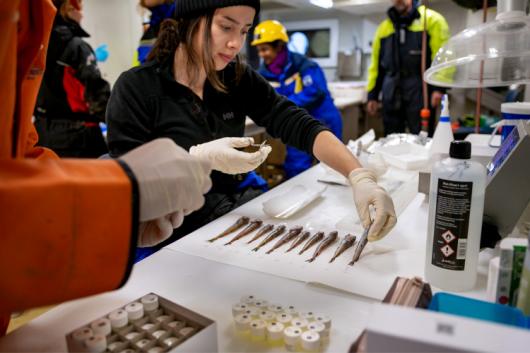How are the Arctic marine environment and ecosystem responding to the changing climate?
To answer this question, the Nansen Legacy project has collected data and samples from the northern Barents Sea and Arctic Ocean Basin through 300+ days onboard the new Norwegian research icebreaker RV Kronprins Haakon during the past five years. Data are stored, shared and archived through the NIRD storage service.
In the photo, you see researchers drilling in the sea ice in front of the research icebreaker RV Kronprins Haakon. They are collecting ice cores for sea ice characterization and conducting studies of life in the sea ice during a winter cruise to the northern Barents Sea in March 2021. Photo credit: Andreas Wolden, IMR/Nansen Legacy.

The largest research project in Norway
The research questions involving climate and responses require a new type of interdisciplinary collaboration that is hard to achieve in a smaller project. Studying these interactions in the Arctic requires a joint effort beyond traditional research projects. The Nansen Legacy is therefore the largest research project in Norway, involving more than 230 scientists from ten Norwegian research institutions with Arctic and marine expertise.
The combined expertise and infrastructure of the 10 partner institutions that involve models, experimental facilities and research vessels, enable the identification and quantification of complex processes and interactions within and between the environment and the ecosystem. The team collects a huge amount of data and samples from the atmosphere, sea ice, ocean and seafloor throughout the year and from the Barents Sea Polar Front to the central Arctic Basin. To analyse and link the data and build knowledge across the spheres, it is crucial to offer a collaboration area for data preparation and storage. That is facilitated by NIRD.

The Artic is getting warming
The research ice-breaker RV Kronprins Haakon is equipped with state-of-the-art instrumentation for underway measurements. That includes acoustic measurements of ocean currents, fish or the sea floor, underway sampling of temperatures, algal concentration and ocean acidification, and meteorological observations. All these data are stored onboard and transferred by the ship operator at the Institute of Marine Research to NIRD to make them accessible. More scientists specific sampling gears is used to collect samples that requires analyses before data can be uploaded and shared. The logistical challenge and costs of Arctic data collection requires optimal use and share.
It has been documented that the Arctic is warming 4 times the global average, and the Barents Sea shows even stronger warming. Atmospheric jet streams and large ocean currents like the Atlantic Water current transport heat to the north, resulting in shorter and less extensive sea ice cover and warmer water that enable more southern organisms to survive further north than earlier, and Arctic species are compressed to smaller regions where sea ice still remains.
FAIR data for the future
The strong and rapid changes is not limited to the Barents Sea or the Arctic. Data handling according to the FAIR principles is therefore crucial to move towards a situation where we can find and connect data across disciplines, regions and the institutions that collect the data to a larger degree than today. Through the Nansen Legacy project, the need to harmonize data handling across the institutions to make them FAIR has required a major step in competence within this field, and Sigma2 provides an important platform that also will secure the data for the future.
The Nansen Legacy
The Nansen Legacy is a collaborative project between 10 Norwegian research institutions with arctic marine expertise, and with competence and perspectives including education, management and contact with different user groups. Project leader is Marit Reigstad from the University of Tromsø.
- Project period: 2018-2024
- Budget: 740 million NOK
- Funding: 50% in-kind from involved institutions, 25% from the Research Council of Norway, 25% from the Norwegian Ministry of Education and Research
- Research group: More than 230 scientists from the involved institutions, about 90 recruitment positions (Master students, PhD and post docs), associated members, international collaborators
